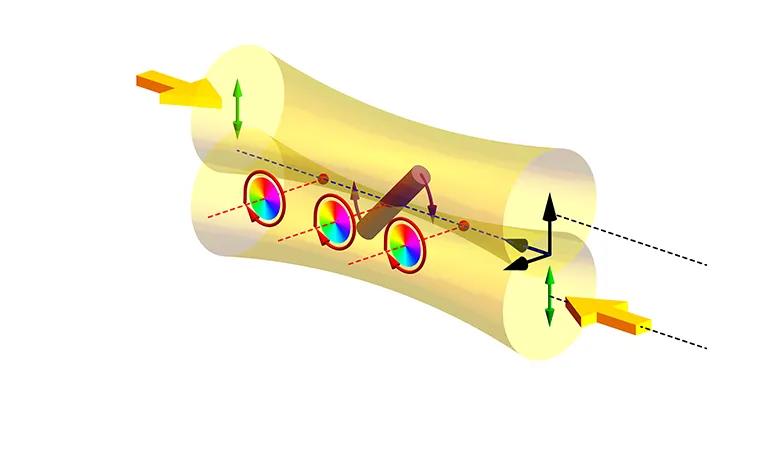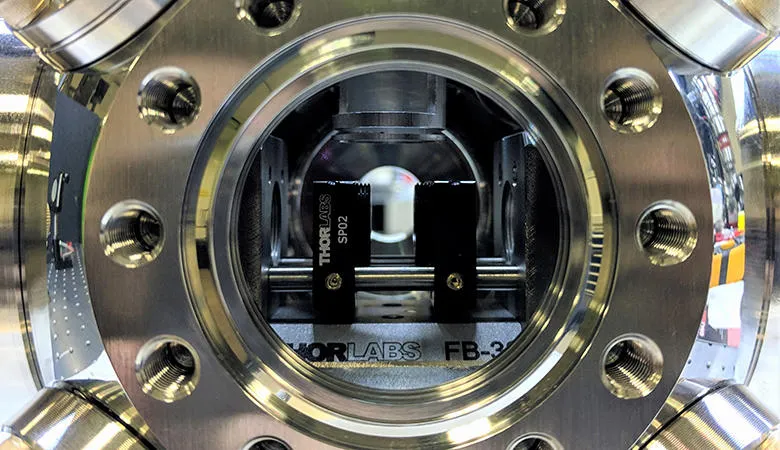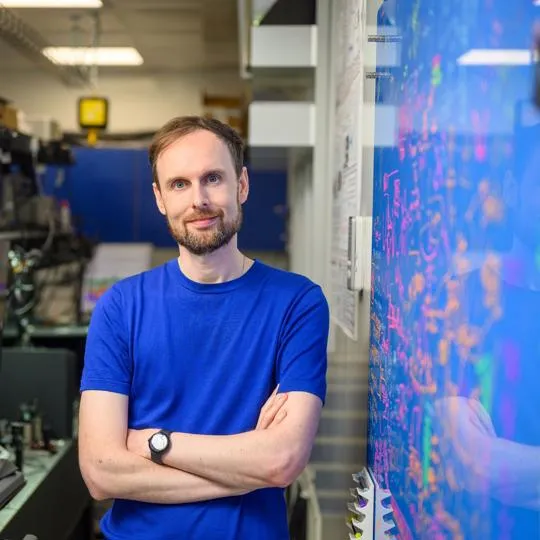We can also experiment with light controlling particles at the nanoscale, using a light field to spin and rotate them, with the aim of advancing our understanding of quantum mechanics.”
Dr Francisco Rodríguez-Fortuño
01 June 2023
Experiment reveals light rotating objects in a direction never seen before
Whirlpools of light exert force 100,000 times greater than seen before in possible breakthrough for the optical manipulation of matter and quantum optomechanics.
An experiment conducted by researchers in the Department of Physics, King’s College London, has revealed for the first time that light is capable of rotating objects in a new direction.
Dr James Millen and Dr Francisco Rodríguez-Fortuño observed transverse orbital angular momentum (TOAM) – whilst conducting experiments with lasers at the nanoscale. Sharing the findings in Nature Communications, they reveal that this new method of rotating matter exerts an exceptionally large torque (or rotational force) on the spinning object. This has potentially huge consequences for our ability to control and manipulate objects with light, as well as advancing our understanding of fundamental physics.
It has been long established that light can move and control objects – a method often called “optical tweezers”.
“Optical fields can carry a rich variety of forms of momenta, including optical angular momentum which drives rotations via light-matter interactions.” Dr Francisco Rodríguez-Fortuño, Lecturer in Physics at King’s explains, “Arthur Ashkin earned a share of the 2018 Nobel Prize in Physics thanks to his development of optical tweezers to help manipulate objects with light. This has wide range of applications in healthcare, biophysics, and nanotechnology.
There are strict rules determining the behaviour of optical angular momentum. Yet thanks to an experiment that didn’t quite go to plan, the researchers at King’s saw something completely new in the way light was causing particles rotate, as Dr James Millen explains,
“We were conducting a tried and tested experiment levitating a silicon nanorod in a light field made from two opposing laser beams. But instead of being stably suspended by the light, the nanoparticles started rapidly spinning. This shouldn’t have been possible as each laser beam didn’t have optical angular momentum.
“With the help of our collaborators, we realised that imperfect alignment of our laser beams was causing the silicon particle to rotate in a direction we’d never seen before. This is the first ever manifestation of transverse orbital angular momentum (TOAM) on an object.”

Not only were the researchers able to spin objects in a new direction, the torque – the measure of force the light was exerting to rotate the object – was five orders of magnitude higher, or 100,000 times stronger, than previously seen.
The findings at first confused Millen and Rodríguez-Fortuño. Normally to rotate an object, the light needs to have circular polarisation – i.e. the electric and magnetic fields that make up the light beam need to be spinning inside the laser beam. But in their manifestation of orbital angular momentum, there was no rotation of the fields. Instead, something entirely different was happening, as Dr Rodríguez-Fortuño describes:
“This experiment, where the two laser beams are slightly offset from each other, creates a series of optical vortices – tiny whirlpools within the light ray. These carried intrinsic transverse orbital angular momentum (TOAM) – with the ability to spin objects.
“This isn’t the first time vortices have been observed in light, but it is the first time they have been observed producing TOAM. It is a surprisingly straightforward method for producing a really novel structure of light.”
The researchers have now replicated TOAM multiple times and built the theoretical models explaining their observations. The agreement between the theory and the experiment is strong, although the outcome is still unintuitive and invites further study.
The researchers believe the findings may have far-reaching impact, as James Millen explains,
“Our ability to control the momentum of light, and its transfer to matter, continues to deliver profound technological innovation.
“This simple creation and direct observation of TOAM potentially opens up a whole new way of controlling objects with light. Small particles such as these are very sensitive to the environment around them. By using TOAM to make them spin, researchers can predict how fast they should turn and what their rotations should be like, and by extension, how forces like gas pressure and magnetic fields impact them. This allows light nanoparticles to act as sensors to detect tiny forces for use in medical scanners, navigation and gas monitoring devices.”

“These findings also have the potential to improve the way we levitate particles in experiments aimed at furthering our understanding of quantum mechanics. Rapidly spinning nanoparticles can be used to detect tiny forces predicted by quantum mechanics but never observed in experiments, this new method could help us to answer some of the biggest mysteries of the universe.”


